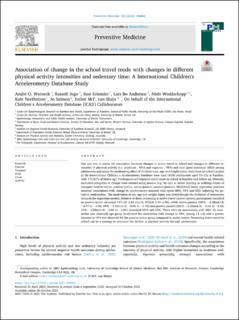| dc.contributor.author | Werneck, André O. | |
| dc.contributor.author | Jago, Russell | |
| dc.contributor.author | Kriemler, Susi | |
| dc.contributor.author | Andersen, Lars Bo | |
| dc.contributor.author | Wedderkopp, Niels | |
| dc.contributor.author | Northstone, Kate | |
| dc.contributor.author | Salmon, Jo | |
| dc.contributor.author | van Sluijs, Esther M F | |
| dc.date.accessioned | 2022-02-16T09:48:46Z | |
| dc.date.available | 2022-02-16T09:48:46Z | |
| dc.date.created | 2022-01-06T18:17:34Z | |
| dc.date.issued | 2021 | |
| dc.identifier.citation | Werneck, A. O., Jago, R., Kriemler, S., Andersen, L. B., Wedderkopp, N., Northstone, K., . . . van Sluijs, E. M. F. (2021). Association of change in the school travel mode with changes in different physical activity intensities and sedentary time: A International Children's Accelerometry Database Study. Preventive Medicine, 153:106862. | en_US |
| dc.identifier.issn | 0091-7435 | |
| dc.identifier.uri | https://hdl.handle.net/11250/2979288 | |
| dc.description.abstract | Our aim was to assess the association between changes in active travel to school and changes in different intensities of physical activity (i.e. moderate - MPA and vigorous - VPA) and time spent sedentary (SED) among adolescents and assess the moderating effect of children’s sex, age and weight status. Data from six cohort studies in the International Children’s Accelerometry Database were used (4108 adolescents aged 10–13y at baseline, with 1.9±0.7y of follow-up). Participants self-reported travel mode to school at baseline and follow-up. Mutually exclusive categories of change were created using passive (e.g. by car) or active (cycling or walking) forms of transport (active/active, passive/active, active/passive, passive/passive). Multilevel linear regression analyses assessed associations with change in accelerometer-assessed time spent MPA, VPA and SED, adjusting for potential confounders. The moderation of sex, age and weight status was tested though the inclusion of interaction terms in the regression models. Relative to those remaining in active travel (active/active), participants classified as passive/active increased VPA (B: 2.23 min/d; 95%CI: 0.97–3.48), while active/passive (MPA: −5.38min/d; −6.77 to −3.98; VPA: −2.92min/d; −4.06 to −1.78) and passive/passive (MPA: −4.53min/d; −5.55 to −3.50; VPA: −2.84min/d; −3.68 to −2.01) decreased MPA and VPA. There were no associations with SED. An interaction was observed, age group moderated the association with change in VPA: among 12–13y-olds a greater increase in VPA was observed for the passive/active group compared to active/active. Promoting active travel to school can be a strategy to attenuate the decline in physical activity through adolescence. | en_US |
| dc.language.iso | eng | en_US |
| dc.publisher | Elsevier | en_US |
| dc.rights | Navngivelse 4.0 Internasjonal | * |
| dc.rights.uri | http://creativecommons.org/licenses/by/4.0/deed.no | * |
| dc.title | Association of change in the school travel mode with changes in different physical activity intensities and sedentary time: A International Children's Accelerometry Database Study | en_US |
| dc.type | Peer reviewed | en_US |
| dc.type | Journal article | en_US |
| dc.description.version | publishedVersion | en_US |
| dc.rights.holder | © 2021 The Authors. | en_US |
| dc.source.pagenumber | 8 | en_US |
| dc.source.volume | 153 | en_US |
| dc.source.journal | Preventive Medicine | en_US |
| dc.identifier.doi | 10.1016/j.ypmed.2021.106862 | |
| dc.identifier.cristin | 1976190 | |
| dc.source.articlenumber | 106862 | en_US |
| cristin.ispublished | true | |
| cristin.fulltext | original | |
| cristin.qualitycode | 2 | |

